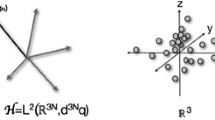Abstract
The particles of quantum mechanics (QM) are discrete undulatory entities which are described in terms of the complex state vectors of the theory in full agreement with experiment. The wave-particle paradox stems from the fact that undulation and discreteness are inconsistent within the classical theory which was historically the point of departure for the canonical foundation. The author describes his prolonged efforts of anchoring the state vector of QM in experiment rather in obsolete theory.
Similar content being viewed by others
REFERENCES
L. Tisza, Phys. Rev. A 40, 6781 (1989).
E. P. Wigner, Commun. Pure Appl. Math. 13, No. 1 (1960). Reprinted in Symmetries and Reflections (Indiana University Press, Bloomington, 1967), p. 222.
L. Tisza, in Experimental Metaphysics, R. S. Cohen et al., eds. (Kluwer Academic, Dordrecht, 1997), p. 213.
A. Einstein, Deutsch. Physik. Ges. Verhandl. 16, 820 (1914).
Rights and permissions
About this article
Cite this article
Tisza, L. Unreasonable and “Unreasonable” in Quantum Mechanics?. Foundations of Physics 29, 491–495 (1999). https://doi.org/10.1023/A:1018883302731
Issue Date:
DOI: https://doi.org/10.1023/A:1018883302731




